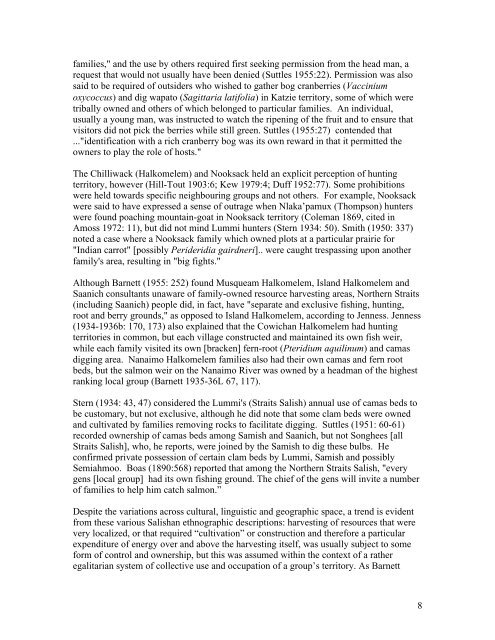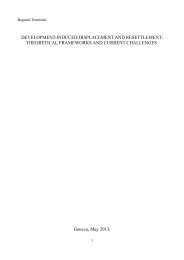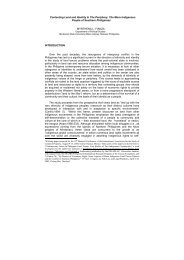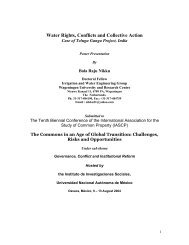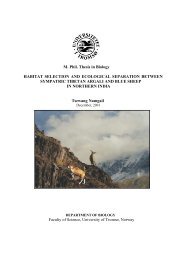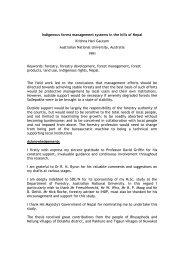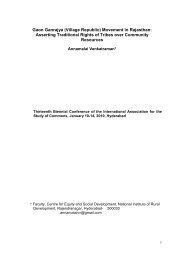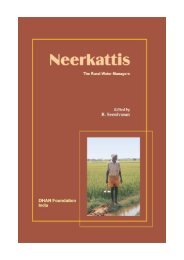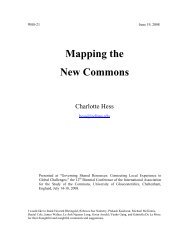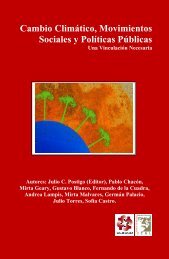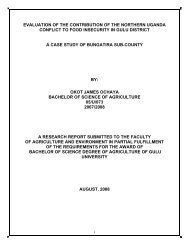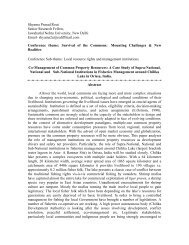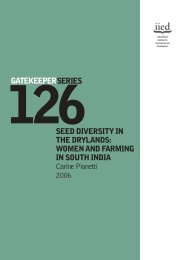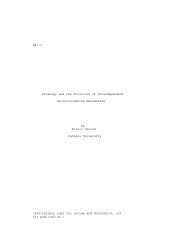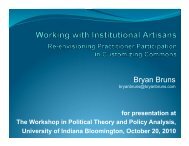Occupying the Land - Digital Library Of The Commons
Occupying the Land - Digital Library Of The Commons
Occupying the Land - Digital Library Of The Commons
Create successful ePaper yourself
Turn your PDF publications into a flip-book with our unique Google optimized e-Paper software.
families," and <strong>the</strong> use by o<strong>the</strong>rs required first seeking permission from <strong>the</strong> head man, arequest that would not usually have been denied (Suttles 1955:22). Permission was alsosaid to be required of outsiders who wished to ga<strong>the</strong>r bog cranberries (Vacciniumoxycoccus) and dig wapato (Sagittaria latifolia) in Katzie territory, some of which weretribally owned and o<strong>the</strong>rs of which belonged to particular families. An individual,usually a young man, was instructed to watch <strong>the</strong> ripening of <strong>the</strong> fruit and to ensure thatvisitors did not pick <strong>the</strong> berries while still green. Suttles (1955:27) contended that..."identification with a rich cranberry bog was its own reward in that it permitted <strong>the</strong>owners to play <strong>the</strong> role of hosts."<strong>The</strong> Chilliwack (Halkomelem) and Nooksack held an explicit perception of huntingterritory, however (Hill-Tout 1903:6; Kew 1979:4; Duff 1952:77). Some prohibitionswere held towards specific neighbouring groups and not o<strong>the</strong>rs. For example, Nooksackwere said to have expressed a sense of outrage when Nlaka’pamux (Thompson) hunterswere found poaching mountain-goat in Nooksack territory (Coleman 1869, cited inAmoss 1972: 11), but did not mind Lummi hunters (Stern 1934: 50). Smith (1950: 337)noted a case where a Nooksack family which owned plots at a particular prairie for"Indian carrot" [possibly Perideridia gairdneri].. were caught trespassing upon ano<strong>the</strong>rfamily's area, resulting in "big fights."Although Barnett (1955: 252) found Musqueam Halkomelem, Island Halkomelem andSaanich consultants unaware of family-owned resource harvesting areas, Nor<strong>the</strong>rn Straits(including Saanich) people did, in fact, have "separate and exclusive fishing, hunting,root and berry grounds," as opposed to Island Halkomelem, according to Jenness. Jenness(1934-1936b: 170, 173) also explained that <strong>the</strong> Cowichan Halkomelem had huntingterritories in common, but each village constructed and maintained its own fish weir,while each family visited its own [bracken] fern-root (Pteridium aquilinum) and camasdigging area. Nanaimo Halkomelem families also had <strong>the</strong>ir own camas and fern rootbeds, but <strong>the</strong> salmon weir on <strong>the</strong> Nanaimo River was owned by a headman of <strong>the</strong> highestranking local group (Barnett 1935-36L 67, 117).Stern (1934: 43, 47) considered <strong>the</strong> Lummi's (Straits Salish) annual use of camas beds tobe customary, but not exclusive, although he did note that some clam beds were ownedand cultivated by families removing rocks to facilitate digging. Suttles (1951: 60-61)recorded ownership of camas beds among Samish and Saanich, but not Songhees [allStraits Salish], who, he reports, were joined by <strong>the</strong> Samish to dig <strong>the</strong>se bulbs. Heconfirmed private possession of certain clam beds by Lummi, Samish and possiblySemiahmoo. Boas (1890:568) reported that among <strong>the</strong> Nor<strong>the</strong>rn Straits Salish, "everygens [local group] had its own fishing ground. <strong>The</strong> chief of <strong>the</strong> gens will invite a numberof families to help him catch salmon.”Despite <strong>the</strong> variations across cultural, linguistic and geographic space, a trend is evidentfrom <strong>the</strong>se various Salishan ethnographic descriptions: harvesting of resources that werevery localized, or that required “cultivation” or construction and <strong>the</strong>refore a particularexpenditure of energy over and above <strong>the</strong> harvesting itself, was usually subject to someform of control and ownership, but this was assumed within <strong>the</strong> context of a ra<strong>the</strong>regalitarian system of collective use and occupation of a group’s territory. As Barnett8


